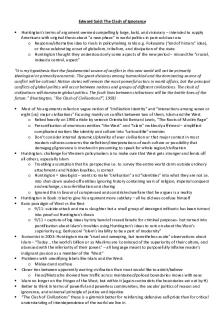Must Finance and Strategy clash PDF

| Title | Must Finance and Strategy clash |
|---|---|
| Author | Lucy Freedman |
| Course | Strategic Management Accounting |
| Institution | University of Bristol |
| Pages | 2 |
| File Size | 43.7 KB |
| File Type | |
| Total Downloads | 35 |
| Total Views | 163 |
Summary
Summary of article...
Description
Must Finance and Strategy clash Barwise, Marsh and Wensley From a financial perspective: - Good investment is one with positive NPV - To have a positive NPV must have enough value to enough customers to support prices and volumes that exceed the costs of supply, inc opp cost. Also the company needs to have enough sources of sustainable competitive advantage to exploit, develop and defend the opportunity. - The financial analysis should highlight these points Good project evaluation needs to consider all of the relevant factors including the hard to quantify ones. Also should account for the consequences of not investing. Use the right base case Ie what will happen if the project is not undertaken. Need to consider the alternative outcome accurately for a fair comparison. It is not usually just a continuation of the status quo. But nothing stands still. Also need to consider the actions of competitors. EG investment in marketing may not increase sales if all other competitors are doing the same, but it may prevent sales from falling if you do not invest. Investment is used to maintain market share; returns may be high compared with base case but profits might still be decreasing. Define project boundaries What is the correct alternative? Exiting the business? Carrying on? Improving distribution and marketing? There are also may different ways to implement the project. It is unrealistic to expect unit managers to take a corporate perspective. Their self interest and own perspective will influence their perception. Need to consider how one unit’s project would affect the other units in the business, eg a plastic bath tub company producing iron tubs would therefore lose some of their plastic bath tub sales. Appropriate time horizon Financial analysis of project often extends over whichever is shorter out of the assets physical economic life or an arbitrary time horizon. In the final year the analysis may include the minimal salvage value for the larger assets. But the finances do not usually explain why the time horizon was chosen. Strategic projects don’t usually have easily defined short lives. Products value to companies can outlast plants. The terminal values should reflect the cash flows over the remaining life of the existing plant or the value of the brand when the plant is replaced. Some managers say that looking beyond 10 years is silly as cash flows will only have a small present value and it is very hard to forecast that far ahead. But many investments are to try and build a market position, research capability, reputation. Evaluate options Options such as R&D, know-how, brand names, test markets and channel developments have value beyond the initial investment. Less obvious is the value of the options to create subsequent products that complement the existing ones.
Truly strategic options are so vague and depend on the manager’s vision. Therefore, financial appraisals of them usually focus on the opportunity itself, not the other opportunities it creates. Unbundle the costs and benefits All investments can be regarded as a bundle of component subprojects. It is useful to unbundle them to simplify analysis and to see better alternatives. Can include smaller projects that wold be hard to justify by itself. Might be counter productive to do it too explicitly, if managers are forced to quantify the benefits of each subproject separately then some good projects may not be accepted. Financial forecasts need to be good enough to gain acceptance but not so good as to become an embarrassment later. Managers are likely to influence the umbers by redefining the project boundaries.
The financial analysis is too often added on afterwards. An interactive process that relates the product-market specifics to the wider financial implication is needed for sound strategic investment and it is a powerful source of organisational learning....
Similar Free PDFs

Must Finance and Strategy clash
- 2 Pages

Said - clash of ignorance
- 1 Pages

Clash Battle Tips - ssdsfsfsff
- 3 Pages

Finance and Accounting
- 4 Pages

Finance and Qantas - wwww
- 2 Pages

Finance and Strategic Management
- 15 Pages

L10 Divorce and finance
- 3 Pages

Agriculture Finance and cooperation
- 179 Pages

Compare AND Contrast Strategy
- 2 Pages

Corporate objectives and strategy
- 14 Pages

BSc Finance and Accounting
- 7 Pages

Traveloka and marketing strategy
- 5 Pages
Popular Institutions
- Tinajero National High School - Annex
- Politeknik Caltex Riau
- Yokohama City University
- SGT University
- University of Al-Qadisiyah
- Divine Word College of Vigan
- Techniek College Rotterdam
- Universidade de Santiago
- Universiti Teknologi MARA Cawangan Johor Kampus Pasir Gudang
- Poltekkes Kemenkes Yogyakarta
- Baguio City National High School
- Colegio san marcos
- preparatoria uno
- Centro de Bachillerato Tecnológico Industrial y de Servicios No. 107
- Dalian Maritime University
- Quang Trung Secondary School
- Colegio Tecnológico en Informática
- Corporación Regional de Educación Superior
- Grupo CEDVA
- Dar Al Uloom University
- Centro de Estudios Preuniversitarios de la Universidad Nacional de Ingeniería
- 上智大学
- Aakash International School, Nuna Majara
- San Felipe Neri Catholic School
- Kang Chiao International School - New Taipei City
- Misamis Occidental National High School
- Institución Educativa Escuela Normal Juan Ladrilleros
- Kolehiyo ng Pantukan
- Batanes State College
- Instituto Continental
- Sekolah Menengah Kejuruan Kesehatan Kaltara (Tarakan)
- Colegio de La Inmaculada Concepcion - Cebu



